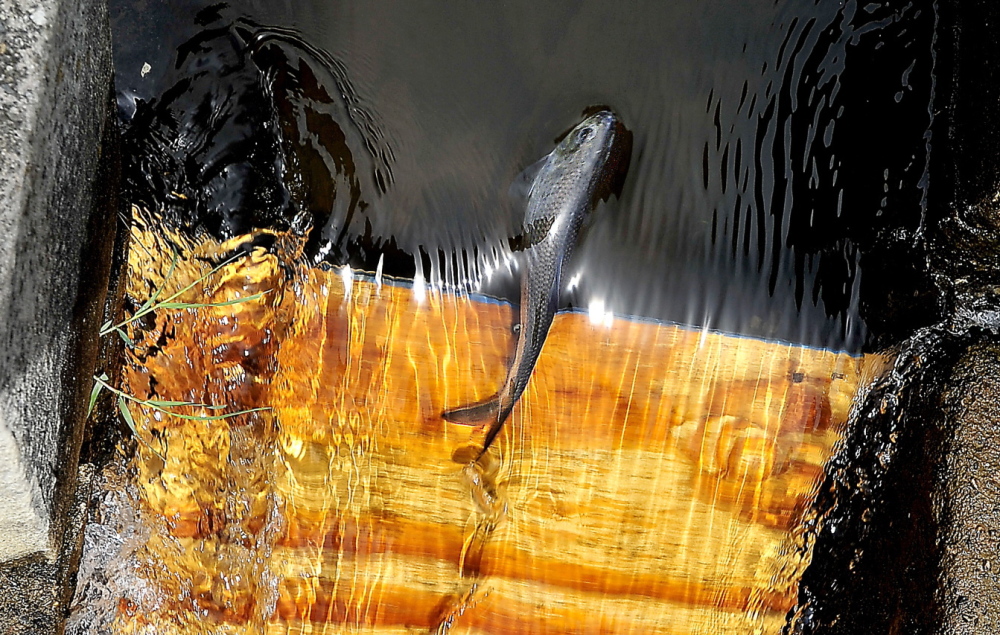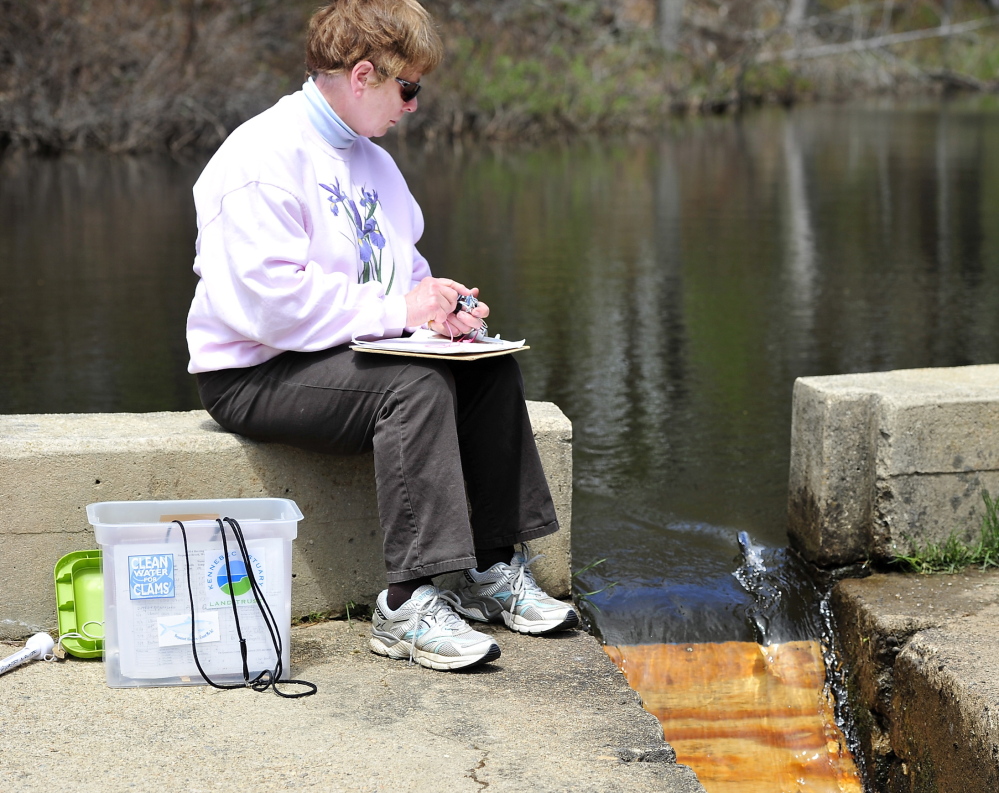WOOLWICH — Lori Benson keeps her eyes focused on the wooden fish ladder at the Nequasset Brook dam, ignoring the eagles and ospreys wheeling overhead.
Every few seconds, a dark gray alewife darts up the ladder and over the dam on its way to spawn in Nequasset Lake. Benson carefully counts every fish that makes its way over the ladder in a timed 10-minute period, clicking a hand-held digital counter for each alewife that passes.
“It is very peaceful,” said Benson, a Bath resident who volunteers for a two-hour fish-counting shift three or four times a week.
But the peaceful – some might say tedious – process of counting fish belies a statewide sense of urgency and concern among scientists, fishermen and conservationists about the future of one of Maine’s most important fish. That concern has prompted hundreds of volunteers to participate in spring alewife counts and other projects dedicated to boosting the species’ numbers in Maine.
The alewife, which returns from the Atlantic each spring to spawn in lakes and ponds, has had a drastic drop in population from its southernmost habitat in North Carolina all the way into Newfoundland.
“The runs are a shadow of what they used to be,” said Claire Enterline, a marine scientist and alewife expert for the Maine Department of Marine Resources.
In the mid-1970s, about 35,000 metric tons of alewives, also known as river herring, were landed by commercial fishing in the United States. Thirty years later, fewer than 50 metric tons were landed, according to the National Marine Fisheries Service, which has put alewives on its list of species of concern.
At the Holyoke Dam fishway on the Connecticut River, counts dropped from 600,000 fish in 1985 to 1,300 in 2003. The population in the St. Croix River, between Maine and Canada, dropped from 2.6 million fish in 1987 to 1,299 in 2004.
Alewife protection in the St. Croix was the subject of a fierce political and legal dispute in 2012-13 among the state and federal governments, conservation groups, sport fishermen and Maine’s Indian tribes.
Counts point to progress
The Maine Legislature resolved the conflict when it passed a law last year that ended a decades-long practice of blocking alewives’ access to fish ladders in the river to protect non-native populations of small-mouth bass.
Scientists believe that alewives’ loss of spawning habitat, to dams and hydroelectric facilities, is a major factor in the decline of the species, along with predators, overfishing and other factors.
While Massachusetts, Rhode Island, Connecticut and North Carolina have imposed a fishing moratorium on alewives, some states allow limited inshore recreational and commercial fishing. Maine has the most concentrated alewife fishery in the nation, with harvesting allowed in 19 communities. At the same time, dozens of efforts are underway across the state to protect the fish.
Volunteer alewife counts are being done on Flanders Stream in Sullivan, at the Bristol Mills Dam on the Pemaquid River and on Patten Stream in Surry. Another one is in the works for Highland Lake in Falmouth. Almost all of the counts still need volunteers, until the season winds down around June 15.
Other counts are being done at fish ladders staffed by the Department of Marine Resources and hydroelectric dam workers on the Saco, Kennebec, Androscoggin and Penobscot rivers.
This year, volunteers and Department of Marine Resources staffers carried alewives by hand over the lower Togus dam in Chelsea.
Enterline, the department’s alewife expert, said the hard work appears to be paying off. She said the alewives, which return only to their native spawning grounds, are doing better in Maine than other states, “which we believe has to do with restoration efforts over the past 15 years.”
In Woolwich, the Woolwich Fish Commission oversees the fishery. For more than 50 years, the commission has hired a member of the Lilly family to harvest the fish. Steve Bodge is the latest family member to hold that job.
The fish swim up Nequasset Brook from Hanson Bay and the Sasanoa River to the dam, where they can turn left and enter a holding pond to await their fate in a smoke house or as lobster bait, or keep swimming forward to the fish ladder.
Local harvest popular
Woolwich Fish Commissioner Bill Potter said the town has kept the fishway open to alewives since the town was founded. For centuries before that, Nequasset Brook was a fishing ground for Indians.
The fish house is open Thursdays through Sundays, when lobstermen line up to buy bushels of alewives for $22 each.
Bodge smokes alewives over green elder wood and sells them for 75 cents each to a dedicated crowd that considers smoked alewives a delicacy – although the fish may be an acquired taste for the uninitiated.
The catch at the fish house has varied, from about 1,400 bushels in 1985 to a low of 200 bushels in 1995.
Ruth Indrick, manager of the fish count at Nequasset Brook, organized by the Kennebec Estuary Land Trust, said 5,572 fish were counted last year and 2,766 were counted in 2012.
Indrick estimates that 40,841 fish made it over the dam last year, up from 29,916 in 2012. The harvest in 2013 was 717.5 bushels – about 86,100 fish – and in 2012 it was 1,111 bushels – about 133,320 fish.
The fish count in Woolwich was started in anticipation of the replacement of the rickety 1950s-era Nequasset Brook fish ladder this summer by the Bath Water District. The water district owns the fishway and manages Nequasset Lake, which serves as Bath’s water supply.
Alicia Heyburn, fish restoration project manager for the Kennebec Estuary Land Trust, said the fish count will continue even after the ladder is replaced.
Heyburn said volunteers come back to watch what she calls one of the world’s great migrations.
“You don’t need to go to Africa,” she said. “You can just come to Woolwich.”
Beth Quimby can be contacted at 791-6363 or at:
bquimby@pressherald.com
Send questions/comments to the editors.





Success. Please wait for the page to reload. If the page does not reload within 5 seconds, please refresh the page.
Enter your email and password to access comments.
Hi, to comment on stories you must . This profile is in addition to your subscription and website login.
Already have a commenting profile? .
Invalid username/password.
Please check your email to confirm and complete your registration.
Only subscribers are eligible to post comments. Please subscribe or login first for digital access. Here’s why.
Use the form below to reset your password. When you've submitted your account email, we will send an email with a reset code.